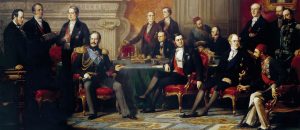The pier of Dolmabahçe Palace, on the morning of November 17, 1922, witnessed one of history’s most poignant and silent farewells. What departed from this pier was not merely the last Ottoman Sultan, Sultan Mehmed VI Vahideddin; a 623-year-old empire, a dynasty, and an era were drawing their last breath under the shadow of a British battleship. Dolmabahçe, which Sultan Abdülmecid had built with his dream of Westernization, served as the final act, witnessing the exile of the last sovereign descended from its own founder. This event is the sharpest moment when the palace ceased to be a center of power and transformed into a symbolic bridge where one era ended and another began.
[Link: The Dynasty and its residents in Dolmabahçe -> /learn/the-dynasty-and-its-people]
The Process Leading to the Abolition of the Sultanate
The process that led to Sultan Vahideddin’s departure from Dolmabahçe accelerated with the victory of the National Struggle and the absolute assertion of the political will of the Turkish Grand National Assembly (TBMM) in Ankara. The invitation by the Allied Powers to both the Ankara Government and the Ottoman Government in Istanbul to attend the Lausanne Peace Conference was the final straw. The stance of Mustafa Kemal Pasha and his colleagues against this attempt to create duality was clear: the sole representative of the Turkish nation was the TBMM. In order to thwart this political maneuver and legally terminate the six-century-old monarchy, the TBMM, through a historic law issued on November 1, 1922, abolished the sultanate—that is, lifted it—by separating it from the Caliphate. With this decision, the Ottoman Empire had officially ended.
[Link: The decision to abolish the Sultanate -> /son-ferman-saltanatin-kaldirilmasi-ve-dolmabahce-sarayinin-imparatorluk-defterinin-kapanisi]
“Traitor or Victim?” Vahideddin’s Decision to Flee
With the abolition of the sultanate, Sultan Vahideddin had become a figure who now only held the title of “Caliph,” devoid of political power. Due to his collaborative stance during the National Struggle, he had been branded a “traitor to the homeland,” and rumors that he would be tried by the Ankara Government were increasing. Believing his life to be in danger within this atmosphere of pressure, Vahideddin wrote a letter to General Harrington, the Commander of the British Occupation Forces in Istanbul, requesting asylum in England. This decision initiated one of history’s most heated debates: Was Vahideddin a traitor who abandoned his homeland, or a victim forced into exile to save his life?. Regardless of the circumstances, the decision of a Sultan to seek refuge with a power he viewed as an enemy was the bitterest confession of how helpless the empire had become.
The Morning of November 17, 1922: The Silent Farewell on the Pier
In the early hours of November 17, 1922, Sultan Vahideddin, accompanied by his young son Şehzade Ertuğrul and a small retinue, left Dolmabahçe Palace, inscribing a final note in history. This departure took place not with a magnificent ceremony befitting a Sultan, but in great secrecy and sadness.
Secret Passage: The Sultan used a small gate in the Harem garden, not the monumental [Link: Imperial Gate -> /imparatorluga-giris-dolmabahce-kapilarinin-guc-ve-protokol-dili] used for ceremonies.
British Ambulance: He departed from the Palace not in a royal carriage, but in a British military ambulance waiting for him at the pier.
Foreign Battleship: From the pier, he was transferred by motorboat to the British battleship HMS Malaya, anchored in the Bosphorus.
The last ruler of the Ottoman dynasty was departing from his own capital, his own palace, aboard an enemy warship. This scene was the visual summary of a lost war, a forfeited sovereignty, and a collapsed empire that could not have been told more powerfully.
The Meaning of Dolmabahçe: The Closing Scene of an Era
With Vahideddin’s departure, Dolmabahçe Palace acquired a meaning completely opposite to its founding purpose. The palace, built to be a showcase opening to the West and a symbol of modernization, became the closing scene of an era by witnessing the farewell of the last Sultan, who fled aboard the ship of a Western power. The 66 years that passed between Sultan Abdülmecid, who ordered its construction, and Sultan Vahideddin, who went into exile, were like a summary of the empire’s journey from hope to collapse. That morning on the Dolmabahçe pier, not only a Sultan but also an empire was bidding farewell to the cool waters of the Bosphorus. The Palace was now empty and awaited its new owner, namely [Link: Atatürk, the founder of the Republic of Turkey -> /padisahin-odasi-milletin-lideri-ataturk-dolmabahceyi-nasil-cumhuriyetin-kalbi-yapti] and the new era he represented.
Conclusion
In conclusion, Sultan Mehmed VI Vahideddin’s departure from Dolmabahçe Palace aboard a British battleship on November 17, 1922, is one of history’s most symbolic moments. This event constitutes the de facto and dramatic end of the Ottoman Empire, which had ruled over three continents for more than 600 years. Dolmabahçe Palace, as the silent witness to this final farewell, completed its role as the “Bridge from Empire to Republic” and closed the book on an era. The steps taken on that pier were the last steps an empire took toward the past.



















